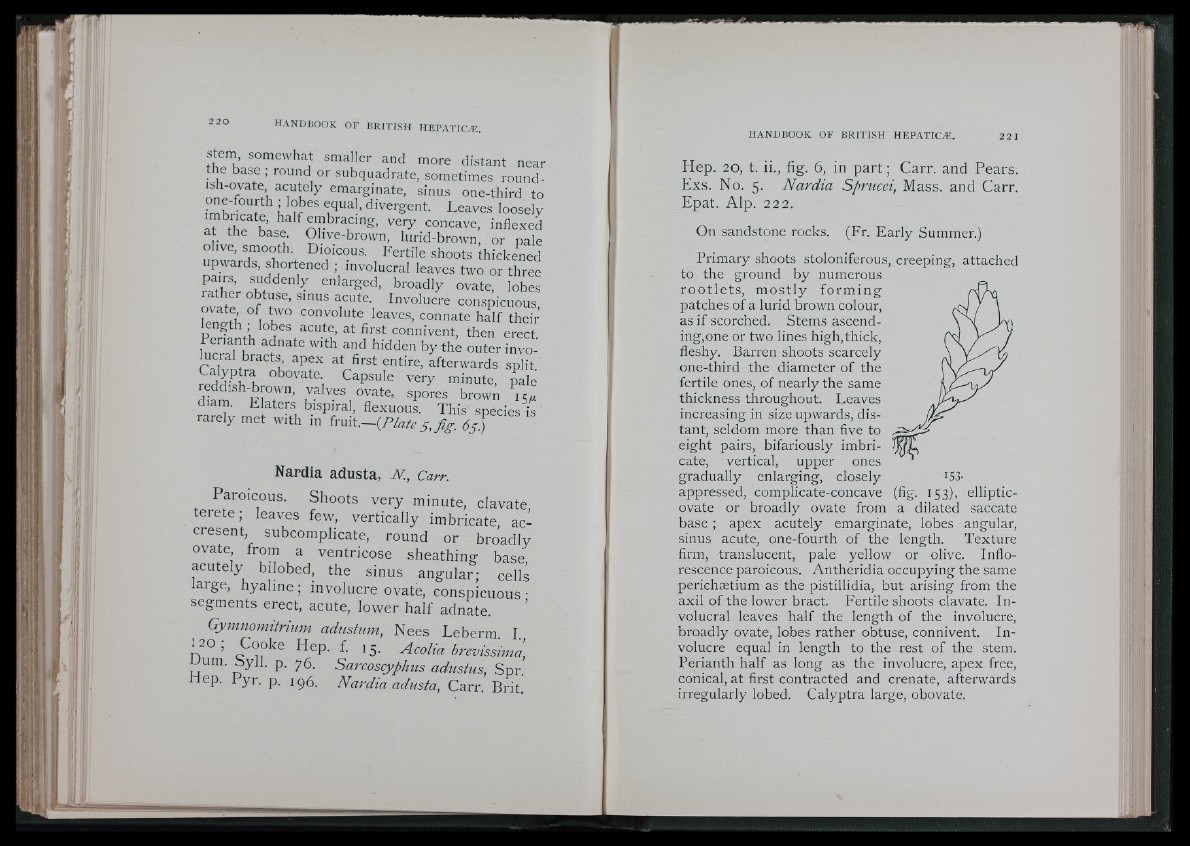
"¡I
stem somewhat smaller and more distant near
the base ; round or subquadrate, sometimes roundish
ovate acutely emarginate, sinus one-third to
one-fourth ; lobes equal, divergent. Leaves loosely
a™t tthier bbpasse . nOrlive-brown, lurid-brown, or pale
olive, smooth. Dioicous. Fertile shoots thickened
upwards, shortened ; involucral leaves two or three
pairs, suddenly enlarged, broadly ovate, lobes
ovÌte n conspicuous,
D n i f r I leaves, connate half their
len,,th lobes acute, at first connivent, then erect
I erianth adnate with and hidden by the outer invo-'
lucial biacts apex at first entire, afterwards split
Calyptra obovate Capsule very minute, pale
reddish-brown, valves ovate, spores brown ic/x
diam. Llatem bispiral, flexuous. This species is
rarely met with in ù u i t - ( P la k g ,fig. óg)
Nardia adusta, M , Carr.
Paroicous. Shoots v e r y minute, clavate
te re te ; leaves few, ver t ical ly imbricate ac^
cresent subcomplicate, round or broadly
ovate from a ventr icose sheathing base
acutely bilobed, the sinus angular ; cells
arge, hyaline ; involucre ovate, conspicuous •
segments erect, acute, lowe r half adnate.
Gymnomitrium adustum, Nees Leberm. I.
Hep. f. 15. A co lia brevissima,
Dum. Sy ll . p. 76. Sarcoscyphus adustus, Spr.
Hep. Pyr . p. 196. Nardia adusta, Carr. Brit,
Hep. 20, t. ii., fig. 6, in p a r t ; Carr, and Pears.
Exs. No. 5. Nardia Sprucei, Mass. and Carr.
Epat. Alp. 222.
On sandstone rocks. (Fr. Larly Summer.)
Primary shoots stoloniferous, creeping, attached
to the ground by numerous
ro o t le t s , m o s t ly form.ing
patches of a lurid brown colour,
as if scorched. Stems ascending,
one or two lines high, thick,
fleshy. Barren shoots scarcely
one-third the diameter of the
fertile ones, of nearly the same
thickness throughout. Leaves
increasing in size upwards, distant,
seldom more than five to
eight pairs, bifariously imbricate,
vertical, upper ones
153-
gradually enlarging, closely
appressed, complicate-concave
ovate or broadly ovate from
base ; apex acutely emarginate, lobes
sinus acute, one-fourth of the length.
(fig. 153), elliptic-
a dilated saccate
angular,
Texture
firm, translucent, pale yellow or olive. Inflorescence
paroicous. Antheridia occupying the same
perichsetium as the pistillidia, but arising from the
axil of the lower bract. Fertile shoots clavate. Involucral
leaves half the length of the involucre,
broadly ovate, lobes rather obtuse, connivent. Involucre
equal in length to the rest of the stem.
Perianth half as long as the involucre, apex free,
conical, at first contracted and crenate, afterwards
irregularly lobed. Calyptra large, obovate.